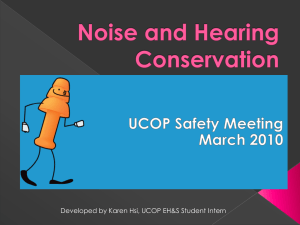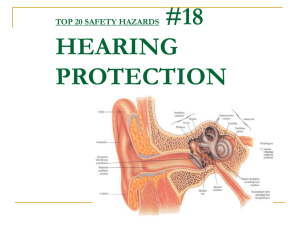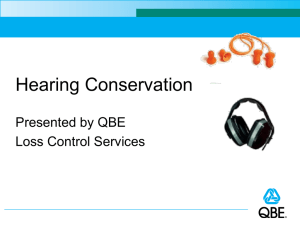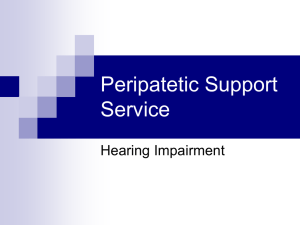Hearing Protection Training Kit
advertisement
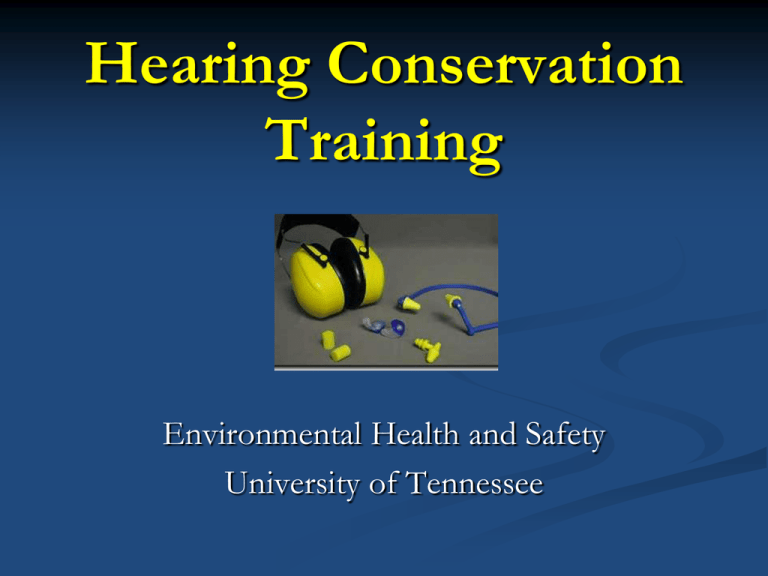
Hearing Conservation Training Environmental Health and Safety University of Tennessee Did You Know? About 30 million workers are exposed to hazardous noise on the job. One in 4 of these workers (or 7.5 million Americans) will develop permanent hearing loss. Noise-induced hearing loss is the most common occupational hazard for American workers Hearing loss from noise is slow and painless; you can have a disability before you notice it If you must raise your voice to speak with someone only 3 feet away, you are in high (hazardous) noise. It is 100% preventable Hearing Conservation Noise Conservation is also called the Noise Standard and is regulated by OSHA (Occupational Safety and Health Administration) OSHA Regulation (29 CFR 1910.95) Goal - prevent hearing loss associated with high noise levels at work NoiseExposure Exposure At Noise at Work Work This presentation will cover the following topics: 1. Identify potential sources of hearing loss 2. Learn how to prevent hearing loss at work 3. Meet regulatory requirements 4. The purpose of audiometric testing and how it works How is Noise Measured? Noise levels are measured in decibels (dB) Decibels are not linear measurements The difference in energy between 100 decibels and 110 is not 10% actually is 100 times the sound level pressure Effects of exposure to loud noise Exposure to loud noise will inevitably cause hearing loss over time. Once the nerves of the inner ear are destroyed or damaged from exposure to excessive noise, the damage is permanent Loud noise damages or destroys the nerves in the inner ear. Another effect can be “tinnitus” or permanent ringing in the ear. Factors Affecting Hearing Loss The following factors can affect hearing loss: Noise Intensity or Sound Pressure Frequency or Pitch of sound Length of Daily Exposure Duration of Exposure in Years Individual Susceptibility Other Factors (disease, genetics, lifestyle, age, etc.) When is Noise Too Loud? • Noise is measured in units called “decibels” or “dB” • If two people 3 feet apart must shout to be heard, the background noise is too loud (above 85 decibels). • Noise above 140 decibels causes pain and immediate hearing loss. Signs of Hearing Loss Difficulty hearing people speak. Inability to hear certain high-pitched or soft sounds. Noise or ringing in ears. Getting complaints that the radio or tv is too loud. Long Term Exposure to Noise • Our ears can recover from short exposure to loud noise, but over time nerve damage will occur. • The longer and louder the noise, the greater chance permanent damage will occur. • There is no such thing as “tough ears” or “getting used to it”. Effects of noise to inner ear Hair cells in inner ear transmit noise signals to the brain Normal hair cells Noise-damaged hair cells Tinnitus From Noise Exposure • Exposure to high noise levels can also cause permanent ringing in the ear or “tinnitus”. • Tinnitus sufferers usually complain of constant whistling, squealing, roaring or buzzing in one or both ears. • Severe tinnitus may disrupt sleep, reduce concentration and cause irritability and depression. What is Too Much Noise Exposure? • Damage from noise exposure depends on the loudness and length of exposure. • Scientific studies have shown that hearing loss can occur when 8-hour average noise exposure exceeds 85 decibels. • The risk of hearing loss increases dramatically as noise levels increase. • Exposure to noise levels above 115 decibels for even five minutes is very risky. OSHA Standard If 8-hour average exceeds 85 dBA then the employer must: 1. Monitor (measure) exposure and notify employee of the results 2. Provide audiometric testing 3. Provide hearing protection 4. Provide training 5. Keep records of monitoring and audiometric testing Daily Allowable Exposure Times to Noise The table below shows noise levels and how long a person can be exposed without hearing protection before there is damage to the ear. Noise Level Allowable Exposure Time 85 decibels 8 hours 90 decibels 4 hours 100 decibels 1 hour 105 decibels 30 minutes 110 decibels 15 minutes 115 decibels 0 minutes Examples of Common Noise Exposures Source dBA Source dBA Whisper 20 Ipod Refrigerator 40 Woodworking 93-120 Conversation 60 Gun Shot 130-140 Average TV 74 Blender 80 90 Riding Motorcycle 90 Snow Mobile 120 Rock Concert 140 Examples of Noisy Equipment Below are some examples of noise levels of various equipment used on campus without the use of hearing protection. Equipment Back Hoe Chain Saw Front-end Loader Gunshot Jackhammer Lawn Mower Tractor Circular Saw Noise Level 85-95 decibels 110 decibels 90-95 decibels 140 decibels 112 decibels 90 decibels 95-105 decibels 90-100 decibels Noise Levels and Permissible Exposure Levels Without Hearing Protection Below is the maximum amount of time a person can spend exposed to this equipment without hearing protection. Chiller Buildings Router 97 dBA Radial arm saw 105 dBA Table saw 96 dBA Portable belt sander dBA 100 14 hours 3 hour 1 hour 3.5 hours 2 hours Examples of Noisy Areas at UT Campus Machine Rooms and Chiller Rooms Steam Plant Wood working shops Motor Pool Operating heavy equipment, such as backhoes, bull dozers Construction equipment, such as: table saws, radial arm saw routers, belt sanders, drills Landscaping equipment, such as lawnmowers and leaf blowers. Noise Control Measures The employer must take some steps to control noise exposure in the workplace, such as: Identifying noise hazardous equipment. Using Engineering, Administrative and Hearing Protection to minimize or eliminate noise exposure. Modifying the source of the noise so it is quieter, using engineering controls. Increasing distance between the employee and the noise hazard. Limiting worker exposure time. Requiring the use of hearing protection devices when the above measures are not feasible and/or do not decrease noise levels below a TWA-8 of 85 dBA. Engineering Controls Engineering controls are the most preferred option in reducing or eliminating the noise hazard by: Reducing or eliminating noise at the source. Interrupting the noise path. Reducing reverberation and structural vibration. Administrative Controls If engineering controls do not work to eliminate the noise hazard, then administrative controls should be considered: Operate noisy equipment on second or third shifts. Rotate employees through high-noise areas. Modify existing machinery. Place noise limit specs. on new equip. Maintain equip. in good condition. Use noise control when installed. Reporting noisy equip. to supervisor for repair. Personal Protective Equipment If engineering or administrative controls do not work to eliminate the noise hazard, then personal protective equipment should be considered as a last resort. This includes using hearing protection, such as ear plugs or ear muffs. Types of Hearing Protection There are three types of hearing protection – ear muffs, earplugs and ear caps. Ear muffs and earplugs provide about equal protection, ear caps somewhat less. earmuffs earplugs ear caps Types of Hearing Protectors All hearing protectors are designed to reduce the intensity (loudness) of noise to the inner ear. They work much better than wads of cotton or bits of cloth stuffed in the ear. All three types have advantages and disadvantages and people Cotton doesn’t vary on which they prefer to work!! use. Hearing Protection – Ear Plugs Earplugs are made of foam, rubber or plastic and are either one-size-fits-all or in sizes small, medium and large. Some are disposable, some are reusable. They are lightweight, and require no maintenance. They are inserted into the ear canal. Ear Plug Comfort Some people may find ear plugs uncomfortable to wear for long periods at first. Ear plugs rarely cause infection or prolonged irritation of the ear canal. Most people can find a comfortable fit by trying several different sizes, types or brands. Custom-molded earplugs can be obtained for maximum comfort. custom molded earplugs Inserting Foam Earplugs Foam type earplugs are one-size-fits-all and must be inserted properly into the ear. Roll earplug into small cylinder first, then insert in ear. Inserting Foam Earplugs Earplug incorrectly inserted Earplug correctly inserted Ear Muffs Ear muffs cover the whole ear and are preferred by some people. They have replaceable pads and some high-tech styles filter out specific noise pitches. They last longer than most plugs. Attached Earmuffs Some muffs are attached to hard hats or goggles. Some high-tech muffs can filter out certain frequencies or have radios inside for communication in high noise areas. Ear Muff Comfort & Glasses Muffs can be uncomfortable in hot weather. Muffs don’t seal well for someone with glasses or heavy sideburns. Ear Caps Ear caps are like earplugs, except they do not go into the ear canal, they only block it. They are good for occasional use or for people who find earplugs uncomfortable. They are not as protective as earplugs or muffs. Noise Reduction of Hearing Protection The “noise reduction rating” or “NRR” of hearing protection is measured in decibels. The NRR is found on the earmuff or earplug package. The higher the number, the greater the protection. How can you hear anything with earmuffs on? Using earmuffs or plugs in noisy areas can actually make it easier to hear coworkers or machinery. They reduce overwhelming loud background noise. They are similar to dark glasses that reduce the sun’s glare making it easier to see. Proper Use of Hearing Protection Earmuffs and plugs provide good protection only when used properly. Sometimes people will remove hearing protection for “just a minute” in a noisy area. In areas of very high noise exposure, this could result in noise overexposure. It won’t protect your ears if it is around your neck!!! Instructions on Selection, Fitting, Use, and Care of Hearing Protectors Ear plugs Keep clean and free of materials Wash in mild liquid detergent and warm water Squeeze excess water and air dry Discard plugs when hardened or do not re-expand Ear Canals Clean like normal ear plugs Do not tamper with the headband and the acoustic seal Instructions on Selection, Fitting, Use, and Care of Hearing Protectors Ear Muffs Keep clean and free of debris Clean cushions with warm soapy water Do not tamper with the acoustic seal between the cushions and the headband Do not modify the ear muffs in any way Do not stretch or abuse the headband Proper Use of Hearing Protection It takes just a few minutes of unprotected exposure at noise above 115 decibels to risk hearing damage. Earplugs not well inserted into the ear canal will not provide complete protection. Likewise, earmuffs not snug against the head will “leak” noise into the ear. Hearing Aids Are Not Hearing Protection Hearing aids do not block out enough sound for most workplace noise. Some hearing aids can actually increase the noise level at the ear. Just turning off the hearing aids will not prevent further hearing loss from noise exposure. Portable Radios/CD Players/iPods • These devices do not provide protection from noise. • The earphones are not earmuffs and the music only adds to background other noise. • The music level in the earphones themselves can exceed 85 decibels and cause hearing loss. Monitoring Environmental Health and Safety or the Department of Hearing and Speech can conduct noise monitoring to determine the level of noise exposure. Sound level meter - gives an instant reading Sound level dosimeter provides an integrated longduration (example 6 hour) reading EHS maintains record of noise sampling Sound Level Meter Sound Level Dosimeter Audiometric Testing All University employees included in the Hearing Conservation Program must undergo initial and annual audiometric testing. Audiometric testing is required by TOSHA for any employees exposed to excessive noise These tests, which are done by trained technicians, are used to gauge hearing loss in affected employees and will be provided at no cost to the employees. The initial test is used as a baseline and the annual test is used to determine if hearing loss has occurred. Purpose of Audiometric Testing The purpose of Audiometric Testing is to: Measure hearing by sending tones to each ear through headphones. Show how one’s hearing compares to normal hearing based on age. Determine whether hearing is being conserved. Alert employee and employer for noise, age or medical related hearing loss. Audiometric Testing Audiometric testing results can be used to check the following: If the hearing protection in use is adequate, If there is a change in noise exposure, If there is a medical condition of the ear unrelated to noise exposure. How Does Audiometric Testing Work? When you are first hired, a baseline test is taken. The testing is repeated every year after that and compared to the baseline test result. If a hearing loss is detected, you will be referred to a doctor or audiologist. Audiometric Testing Audiometric testing produces printed audiograms which show hearing ability at several pitches or frequencies. These frequencies include those of the human voice. The second and following year tests are compared to the first year tests or baseline. If there is hearing loss of 10 decibels or more in the human voice frequencies, you will be sent to the doctor or audiologist. What is an Audiogram? An audiogram is a printed chart of the results of the hearing test. They look similar to the results below. Normal hearing Severe hearing loss Training Training is required for employees who are exposed to noise at or above 8 hr TWA of 85 dB. Topics must include: Effects of Noise on Hearing Purpose of Hearing Protectors Advantages and Disadvantages of Different Types of Hearing Protectors Attenuation of Different Types of Hearing Protectors Instructions on Selection, Fitting, Use, and Care of Hearing Protectors Purpose of Audiometric Testing Employer Responsibility Employers are responsible for the following: Provide occupational noise training. Provide hearing protection devices. Demonstrate commitment – wear hearing protection devices, or PPE, when required. Enforce the use of PPE. Keep up to date with PPE selection and use. Encourage questions and resolve problems. Employee Responsibility Employees are responsible to: Understand the need for personal protective equipment and audiometric testing. Wear PPE and seek replacements when needed. Encourage co-workers to wear PPE. Communicate problems to supervisors. Copies of the OSHA Standard and Related Information UT Hearing Conservation Policy found in EHS Safety Manual – GS 20 OSHA standard available in the EHS office or online at: http://www.osha.gov/pls/oshaweb/owadisp.show_document? p_table=STANDARDS&p_id=9735&p_text_version=FALSE OSHA Standard: 29 CFR 1910.95 Questions and Assistance Please contact Environmental Health and Safety at 974-5084 for assistance with training, scheduling audiometric testing, monitoring, guidance on ways to minimize noise exposures, or any other questions. Visit our web-site at http://web.utk.edu/~ehss/default.html QUIZ To complete the Hearing Conservation Training Module, please click here for the quiz.

